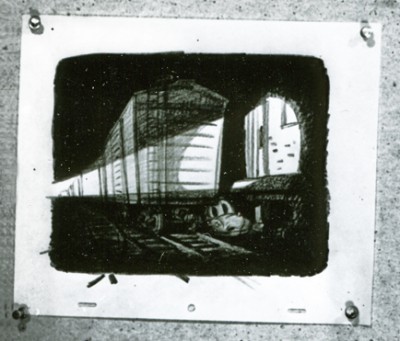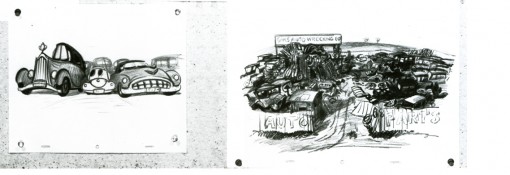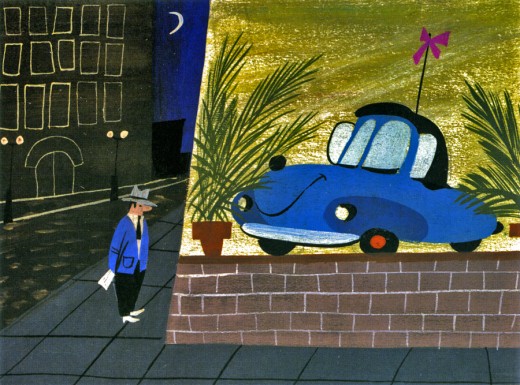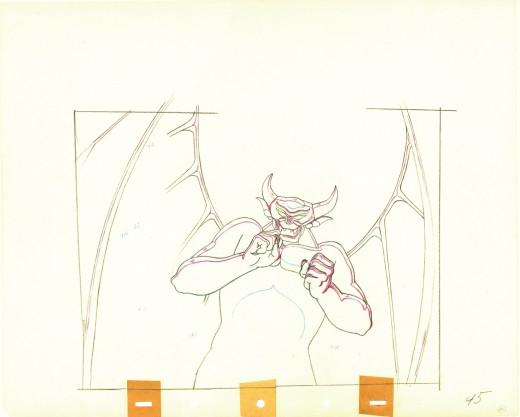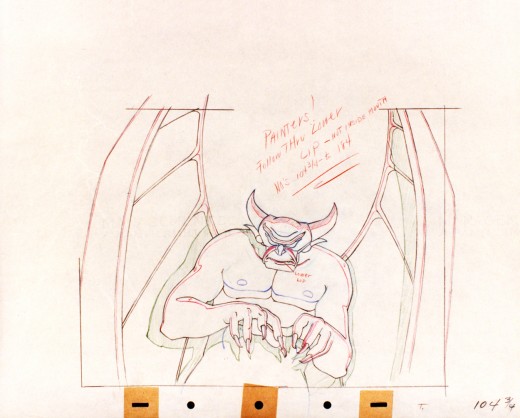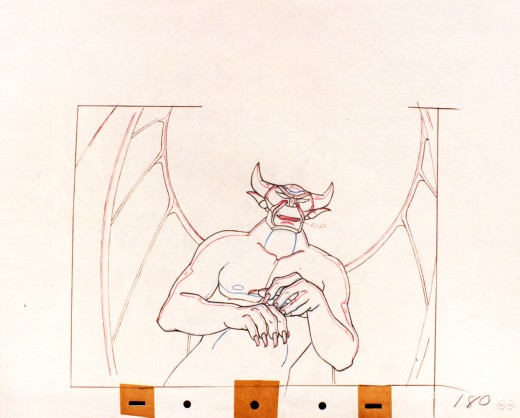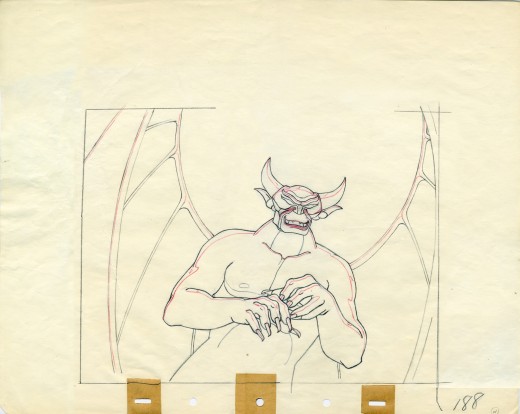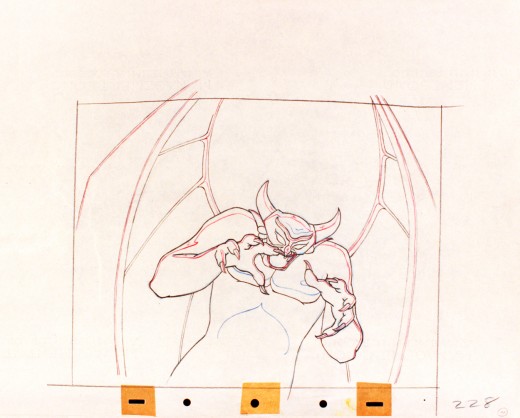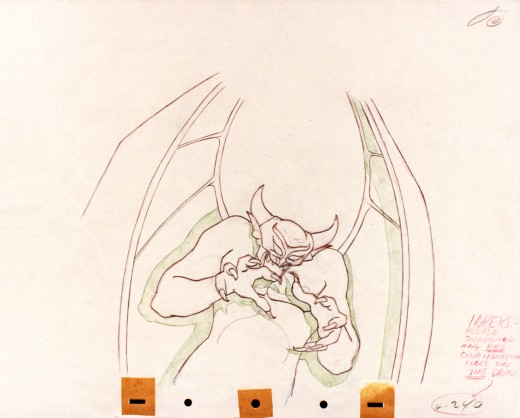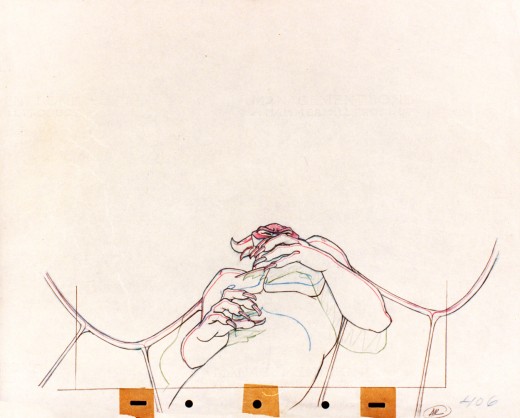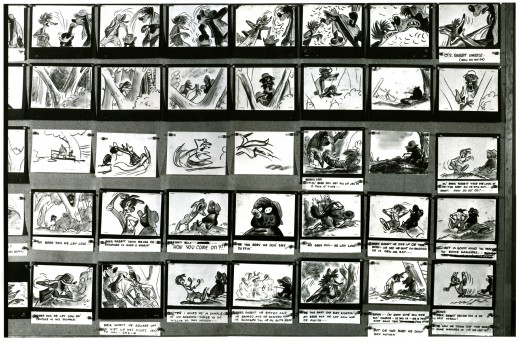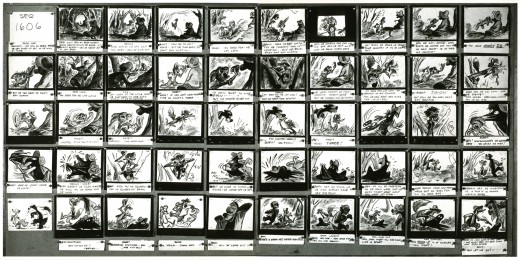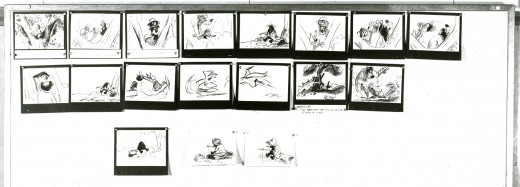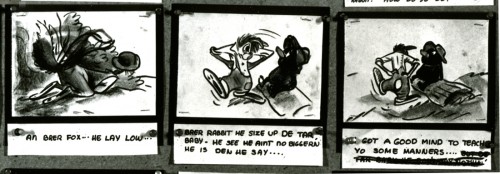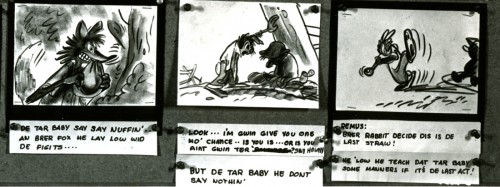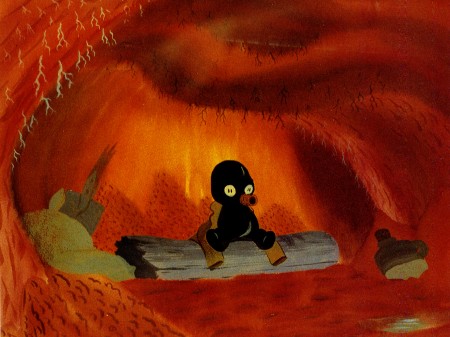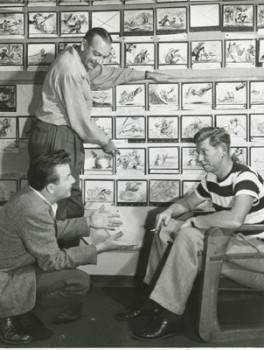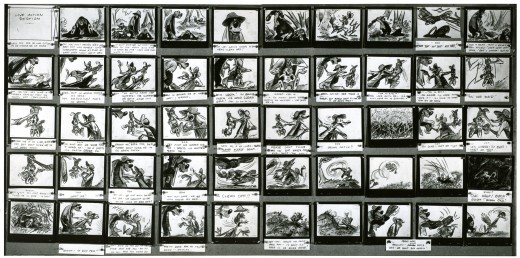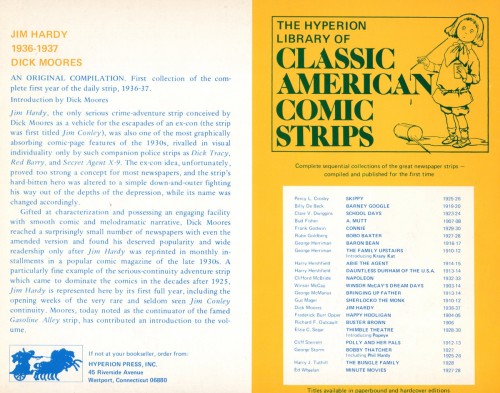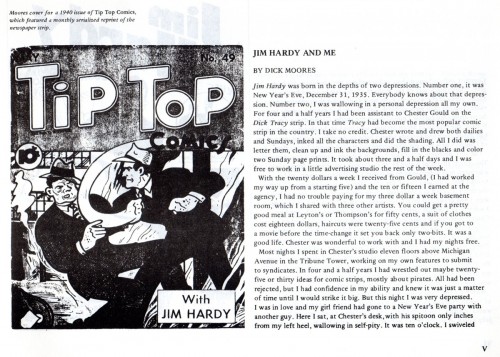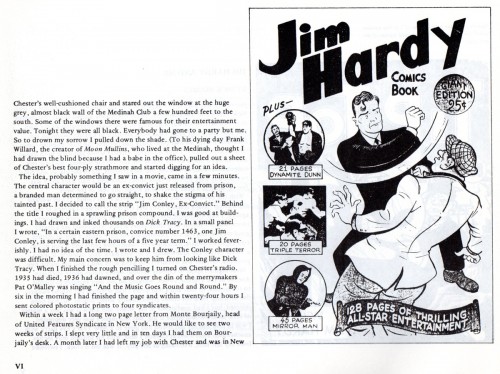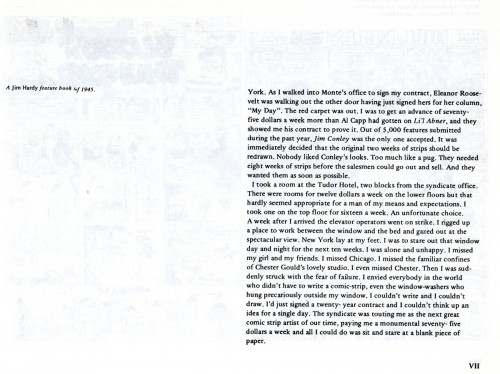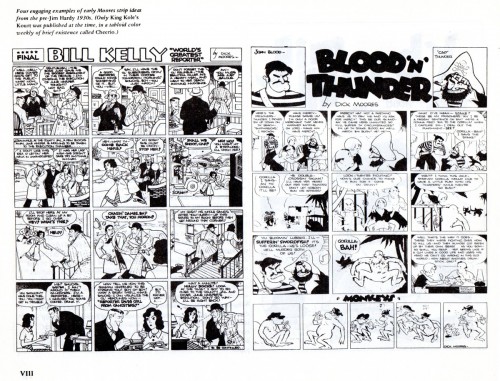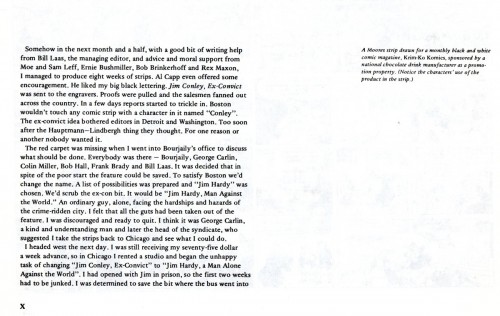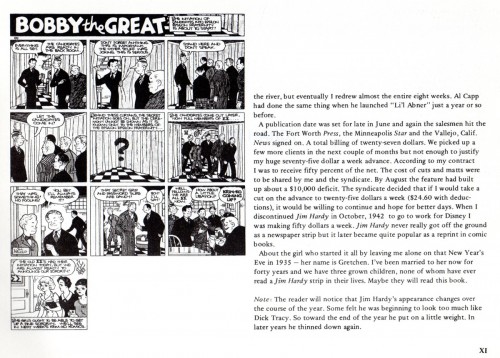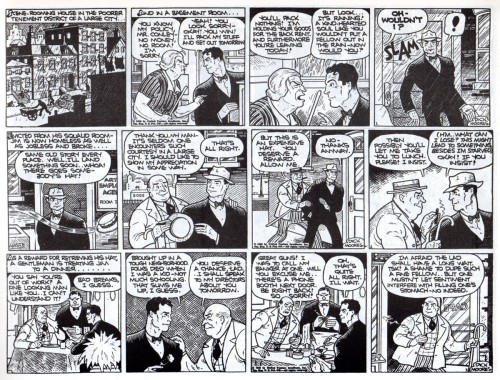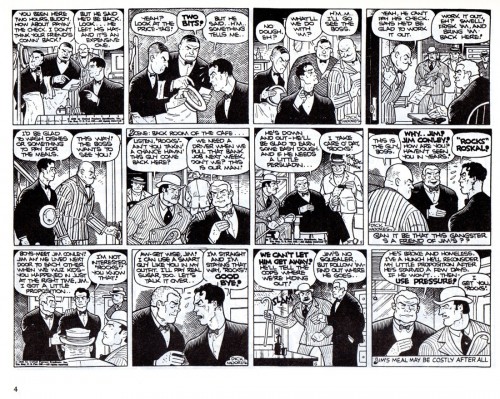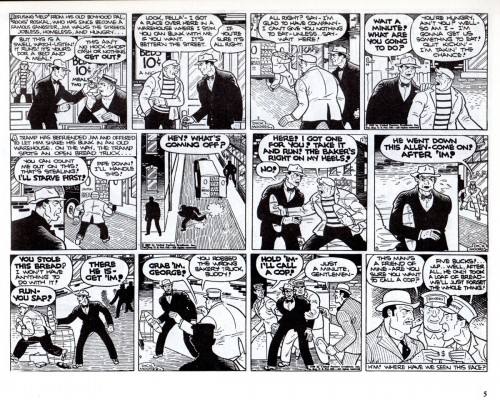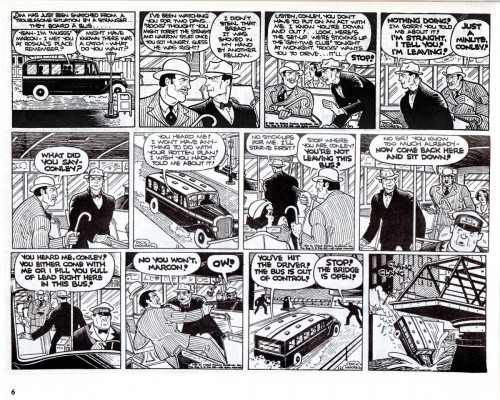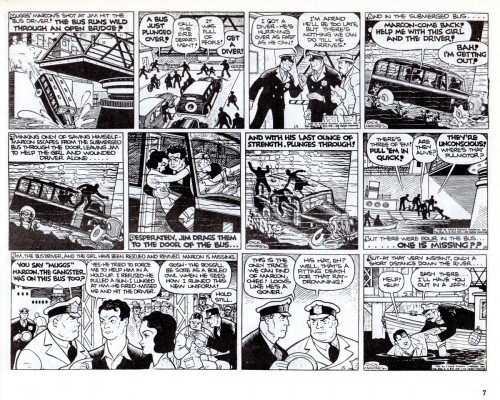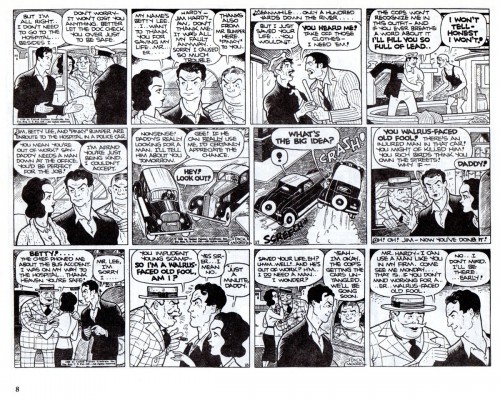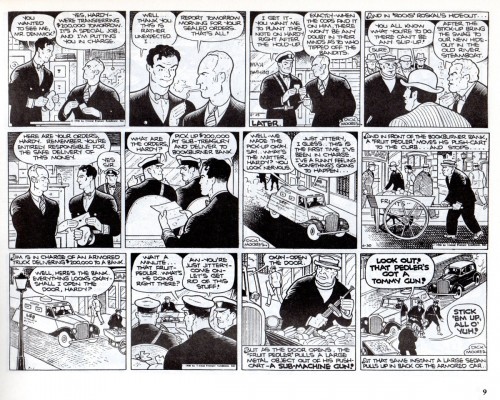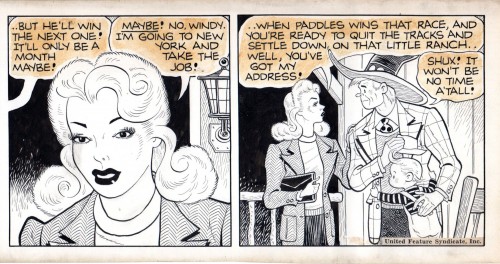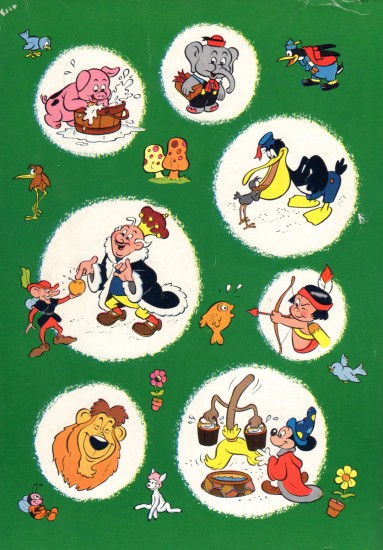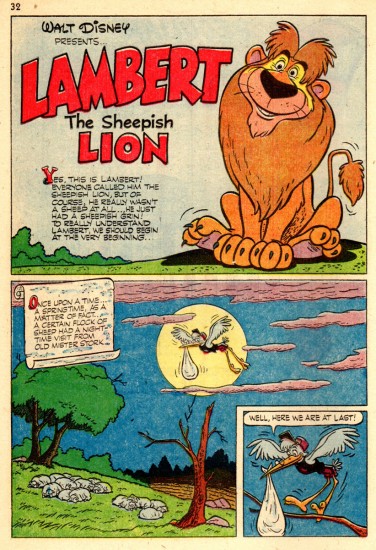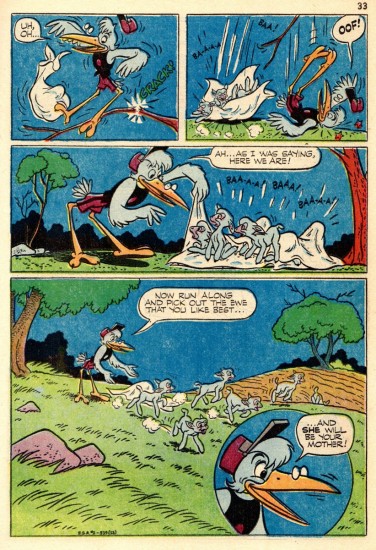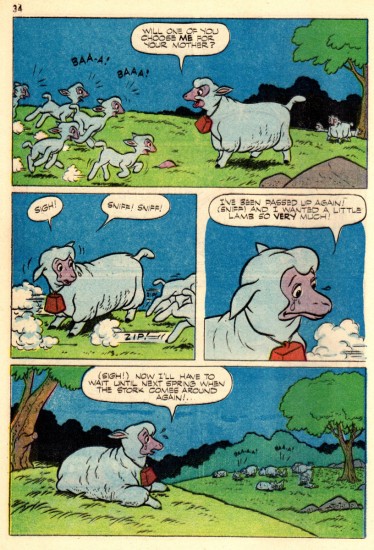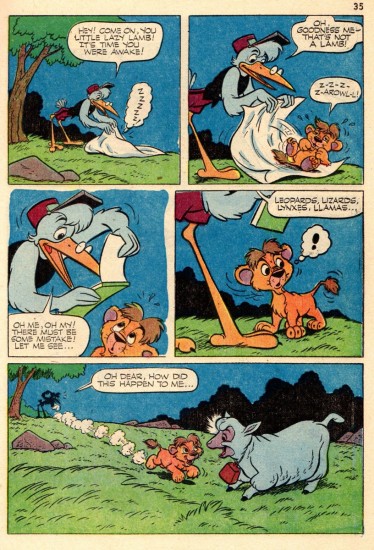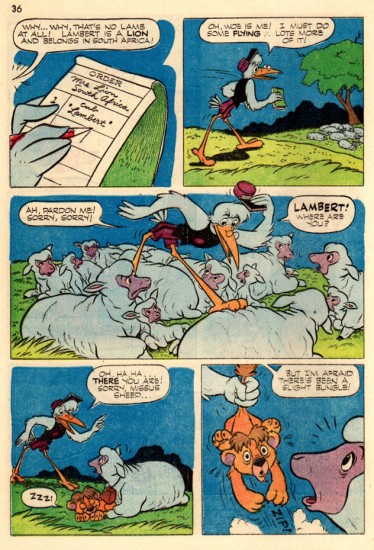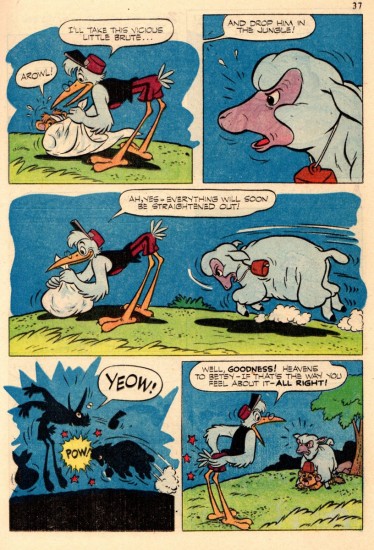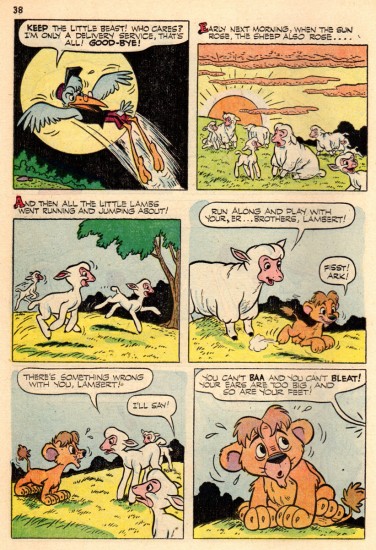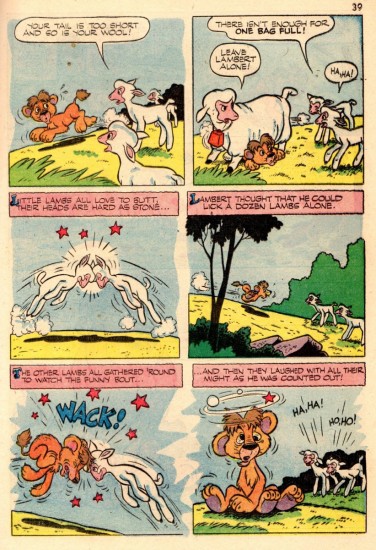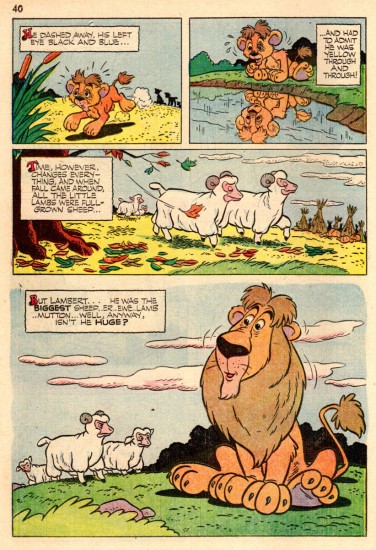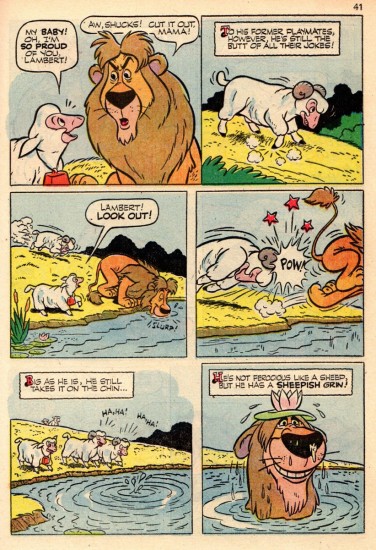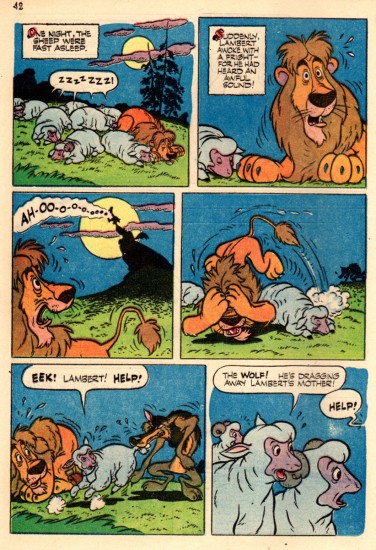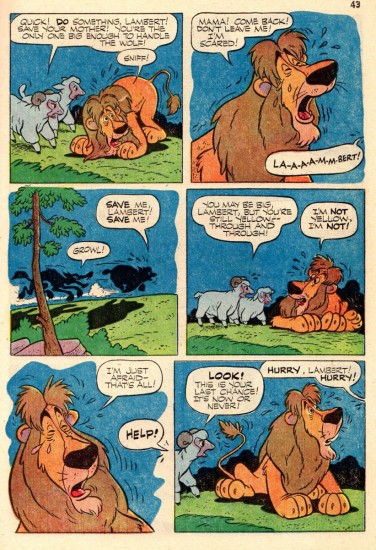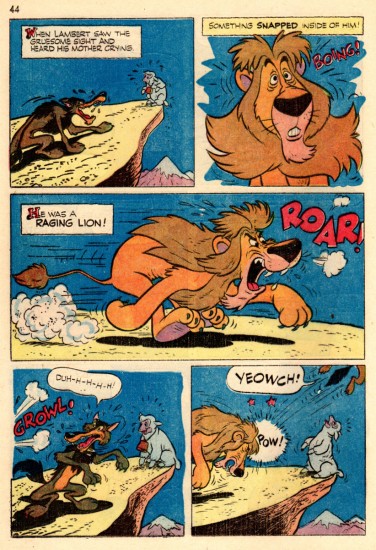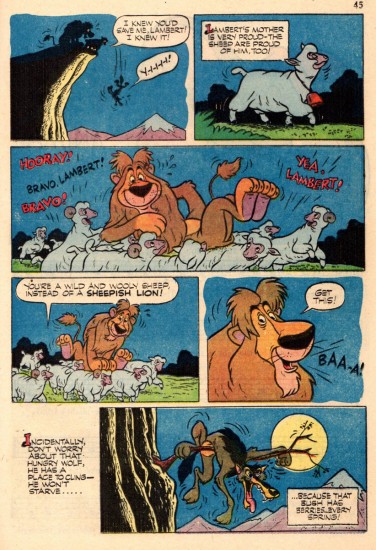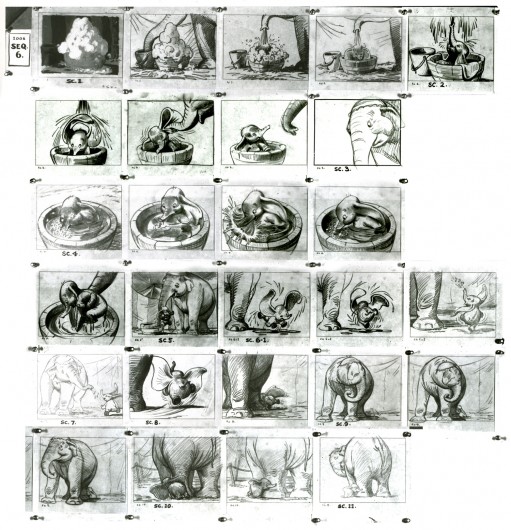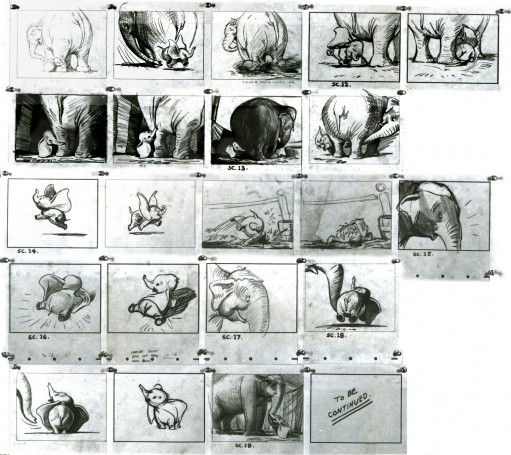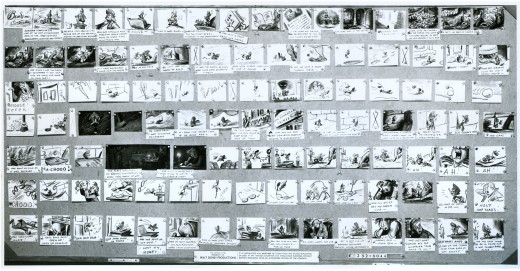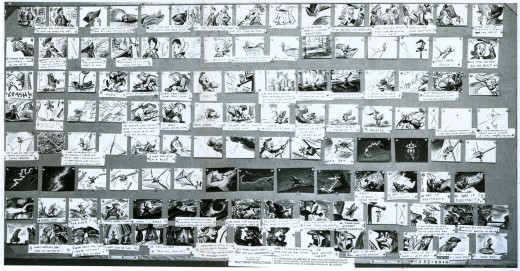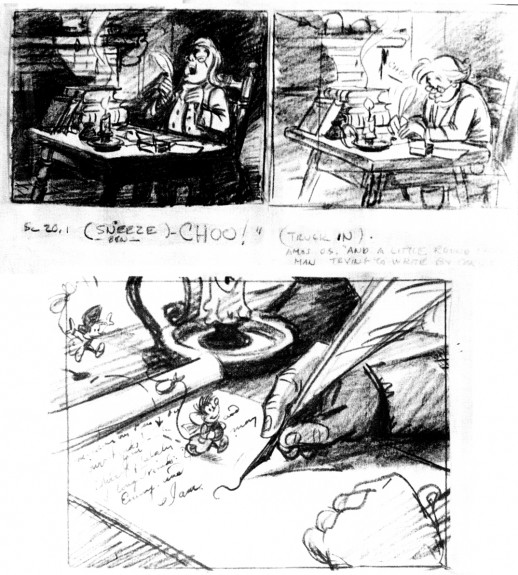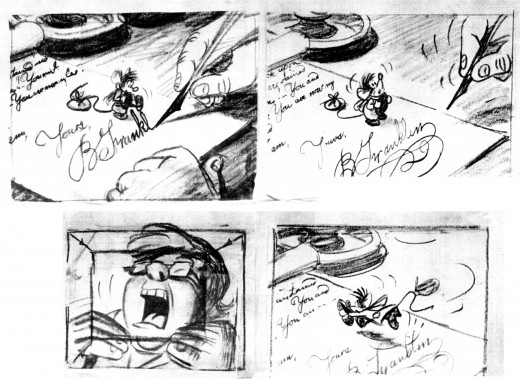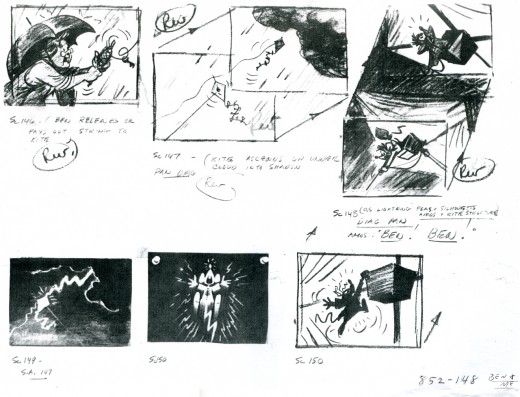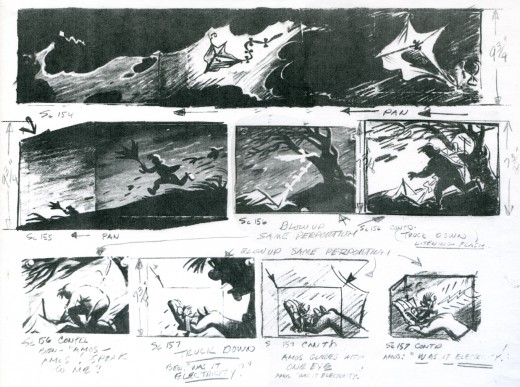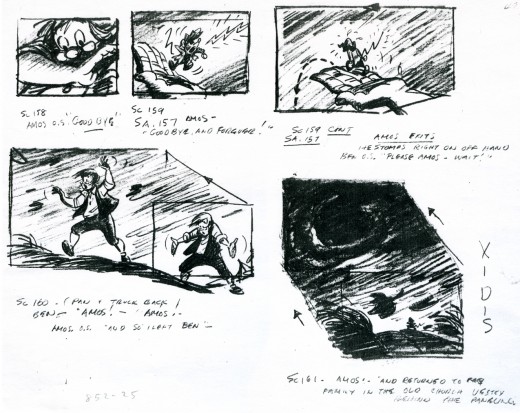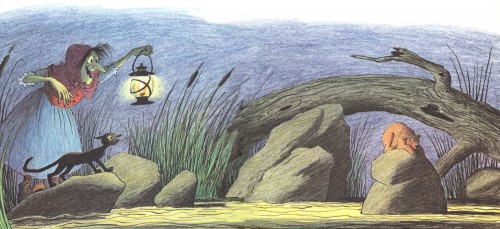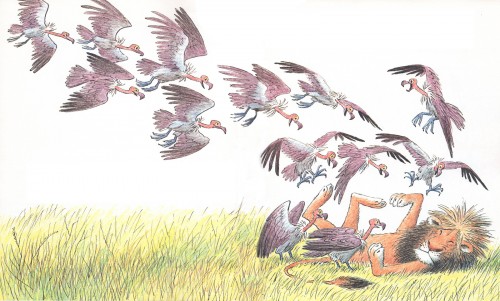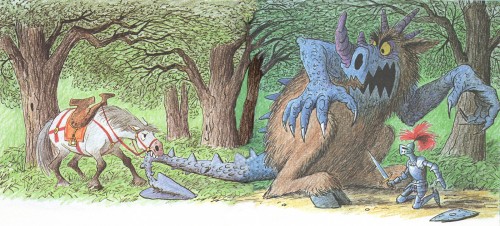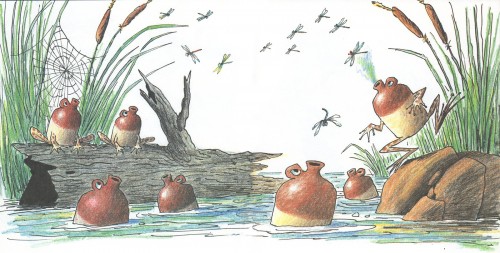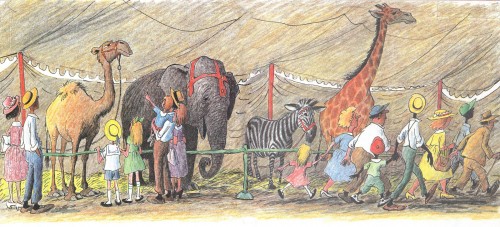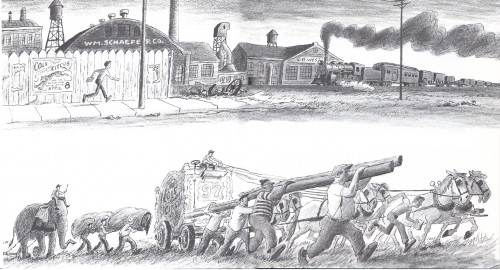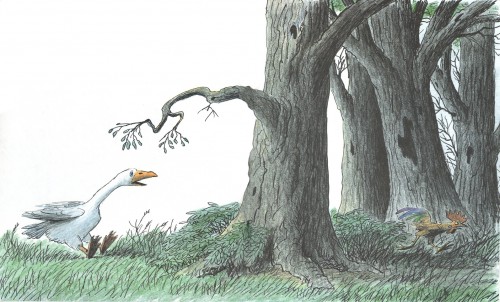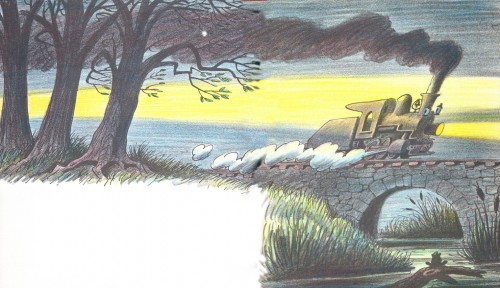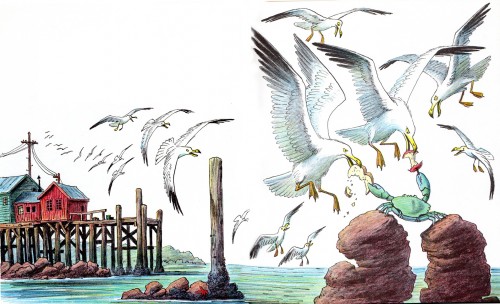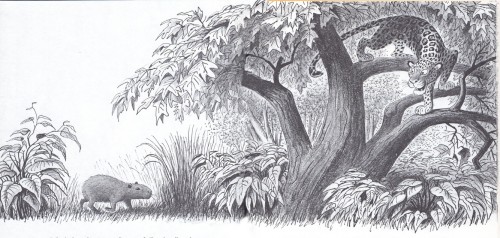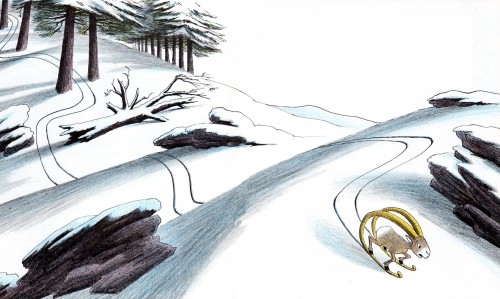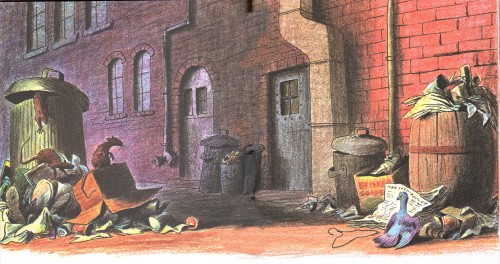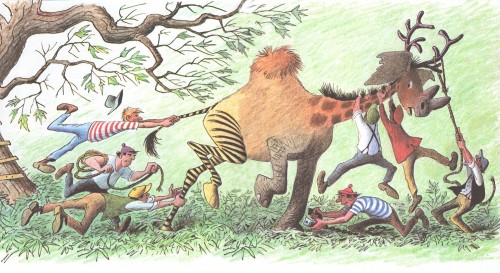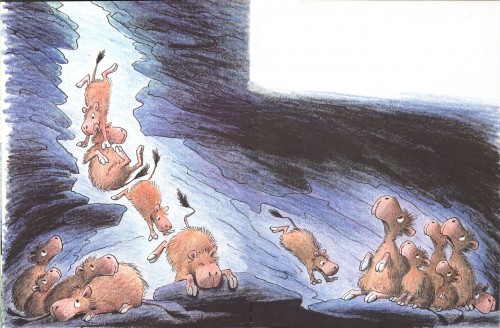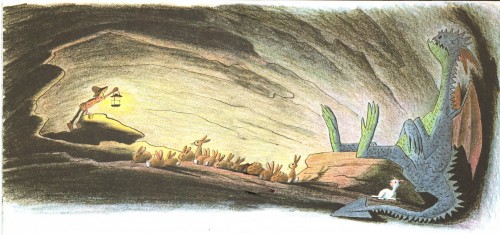Category ArchivePeet
Disney &Peet &Story & Storyboards 15 May 2013 05:54 am
Peet’s Susie Board
- In yesterday’s post, we saw artwork that Bill Peet had done. It was obviously art that was prepared for a book. Whether he was doing this for himself or the studio I can’t say. I do know for sure that it didn’t become a book, but I do know it did develop as a film completed in 1951.
That film was directed by Clyde Geronomi.
The Layout was by Don Griffith and Hugh Hennesy.
The animation was by Bob Carlson, Ollie Johnston, Hal King and Cliff Nordberg.
The backgrounds were by Ralph Hulett.
The music was composed by Paul Smith.
Thanks again to John Canemaker, I have the storyboard by Peet for this short Disney film.
As in the past I’ve broken the board down so that I could post it as large as possible so that you can read it when the images are enlarged. Enjoy.
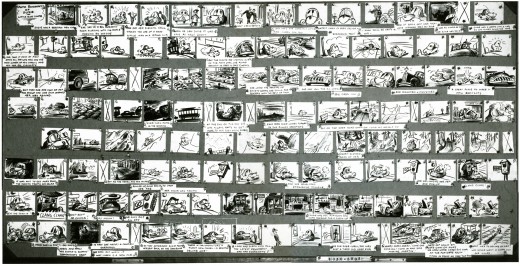
This is the complete board. I’ve broken up each individual row, they appear below.
The following seem to be LO drawings and don’t appear to be part of the storyboard. Perhaps it was prepared for a Leica reel? Regardless, the drawings are interesting, though I doubt Bill Peet did them all.
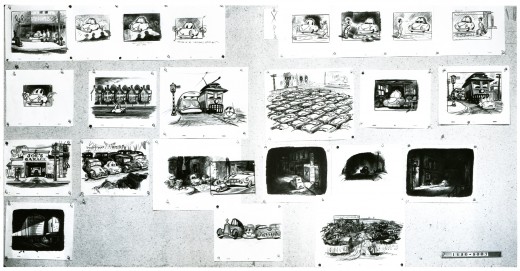
As with other recent posts of storyboard material, I’ve
broken it up and repositioned the images so that you can
enlarge them for better viewing. The above image represents
what the photo given me looks like.
Finally, I wanted to give an indication of the film’s color, so
I’ve gone back to John Canemaker’s book,
The Art and Flair of Mary Blair,
and have taken this color sketch she did in styling
to represent the film as a whole.
Action Analysis &Animation &Animation Artifacts &Commentary &Disney &Peet &Tytla 08 Apr 2013 05:05 am
Stanislavsky, Boleslavsky and Tytla’s Smears & Distortions – 4
Boleslavski was a great admirer of Stanislavsky and his acting techniques. When he, Boleslavsky, came to the United States, he taught the Stanislavsky technique to his students. These included Lee Strasberg, Stella Adler and Harold Clurman; all were among the founding members of the Group Theater (1931–1940). The Group Theater was the first American acting ensemble to utilize Stanislavski’s techniques, and its members all went off to espouse their own versions of the “method.” American acting had taken some real turns into the creation and development of a true system for getting the best performance out of the actor.
In animation, there was animation technique and styles. These rarely had anything to do with acting. However, there were a number of animators at the Disney studio who wanted to put the focus on their acting and actually studied Stanislavsky and Boleslavsky so that their characters would give a great performance. Tytla was certainly a leader among the animators to do this.

Whereas in Pinocchio, while working with such a flamboyant and
eccentric character, Tytla stretched and distorted Stromboli to
get the necessary and sudden emotional mood shifts desired.

With Dumbo, Tytla modeled the character after his own son,
and he animated this scene wholly on the two characters
given to him on the strong storyboard by Bill Peet.

He didn’t use distortion, because it wasn’t the character he was animating.
Dumbo was gentle, all truth. The honest performance meant keeping everything
above board and on the table. That is undoubtedly the performance Tytla drew.

In my opinion, it has to be one of the greatest animation performances
ever drawn for a film. It’s quite extraordinary and cannot be undercut
in any possible way.
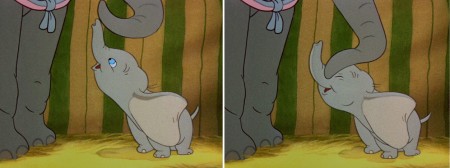
(Click any image to enlarge.)
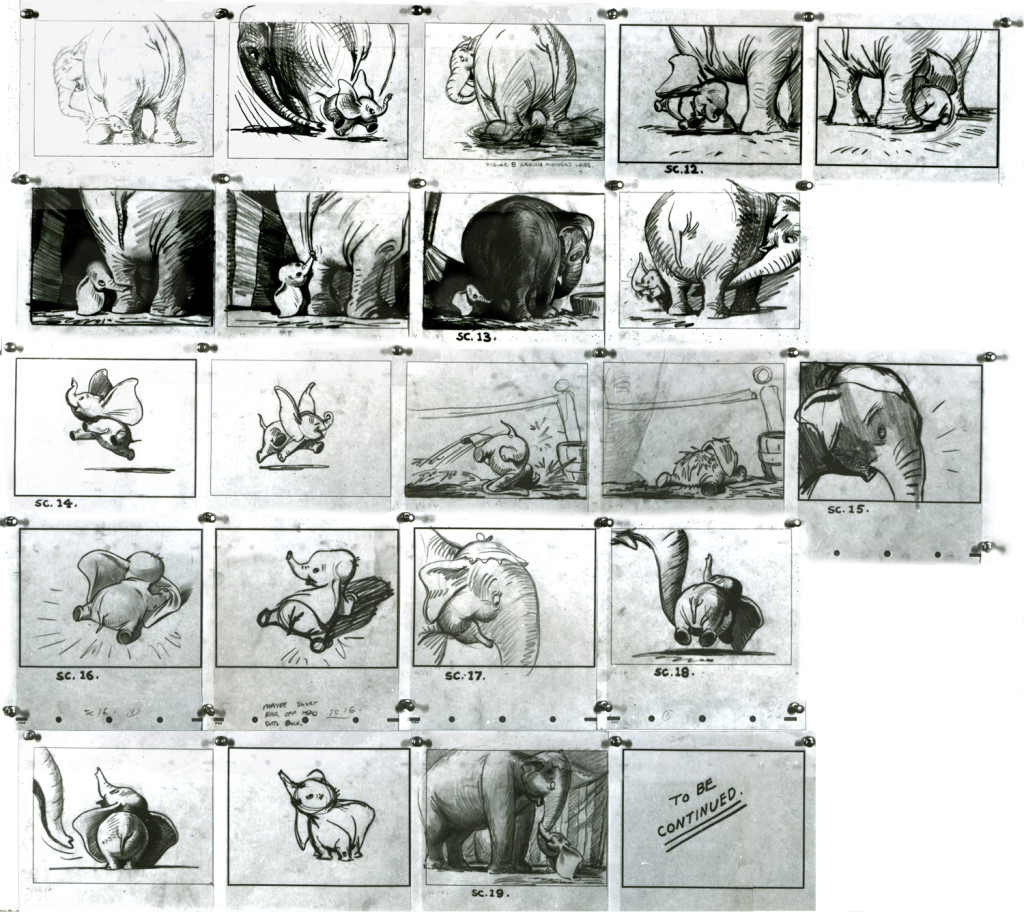
You can see that Bill Peet’s storyboard was certainly an inspiration,
at the least, for Tytla to follow, if not to equal.
Let’s move to another film. Fantasia.
Vladimir Tytla worked on the devil in Mussorgsky’s – Night On Bald Mountain.
Here are some drawings for the scene. They’re part Tytla and part clean up by his assistant.
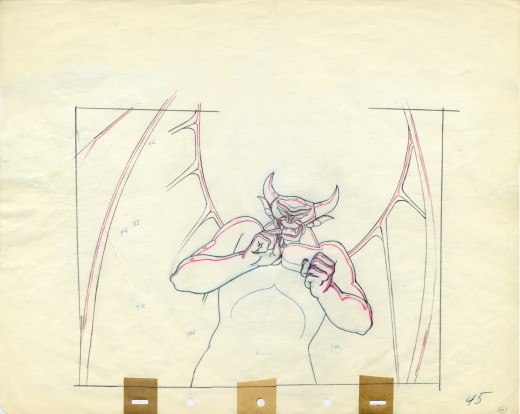
A good example of a Tytla drawing.
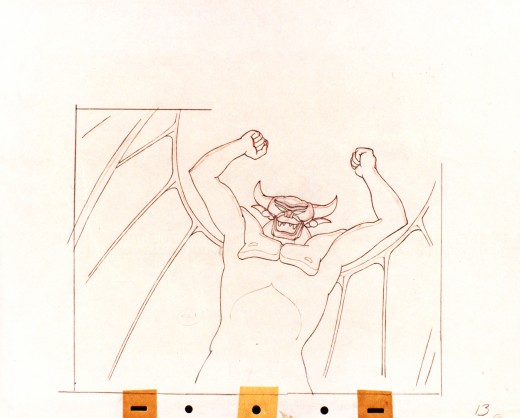
They’re pretty damned impressive drawings. If there is any distortion,
it comes from making a body builder’s shape stronger. There’s no violent
flexing of those muscles, just the natural thing on display in the middle
of a dance sequence. Strong and forcefully beautiful drawings. The
distortion is done by the other spooks floating out of their graves on
the way up to their leader.
The devil’s motion throughout this piece is very slow, tightly drawn images of the devil lyrically moving through the musical phases. It’s pure dance. Any distortion is done via the tight editing that Tytla has constructed. Very close images of the hands with the flame shaped dancers moving about in tight close up as Chernobog’s large face with searing eyes closely watching the fallen creatures dancing in his hands. It’s distortion enough.
Tytla has constructed the most romantic sequence imaginable, and the emotion of the dance acts as the climax for all of Fantasia, and it succeeds in spades. All hoisted by the animation, itself. No loud crushing peak, just a dance done in a tightly choreographed number completely controlled by Tytla. It’s the ultimate tour de force of animation, and we’ll never see the likes of it again.
So essentially I’m pointing out that Tytla used distortion in the animation drawings to execute his acting theories, but as he grows, he not only uses his animation (and animation drawings) to “Act”, he uses his abilities as an Animation Director. The cutting and the movement of the scenes is used for the Acting, as well.
Disney &Peet &Story & Storyboards 21 Feb 2013 06:46 am
Tar Baby – repost
- Back in Oct 2007, I posted Bill Peet‘s excellent storyboard for the Tar Baby sequence from Song of the South.
Given yesterday’s post of color sketches and storyboard drawings from this film, and given that the original posting of these boards was done relatively small, I thought it time to put them up again, but I’ve taken the time to break them down and post them in a slightly larger form, making them a bit more legible.
As with other recent boards loaned me by John Canemaker, I first display them in the original size of the stats as they came to me.
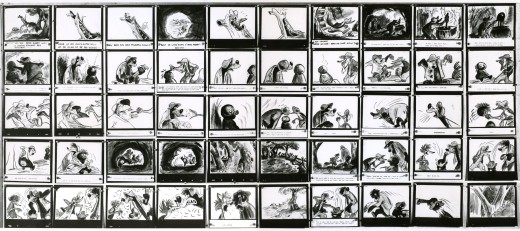 1
1
(Click to enlarge images so you can read them.)
Here is my breakdown of the boards:
 1a
1a
 42a
42a
I just love the drawings from this section.
There are another two pages of the storyboard
which I’ll break down and post tomorrow.
.- Here’s the conclusion to the storyboard by Bill Peet that I began yesterday. It’s the Tar Baby sequence from Song of the South.
I first posted this in October 2007, but I hadn’t broken up the board so that it could be enlarged enough. I’ve done that.
Many thanks go to John Canemaker for initially lending this material for me to post.
.
.
.
This picture comes from the Bill Peet website, worth a visit.
Here are the two remaining original boards:
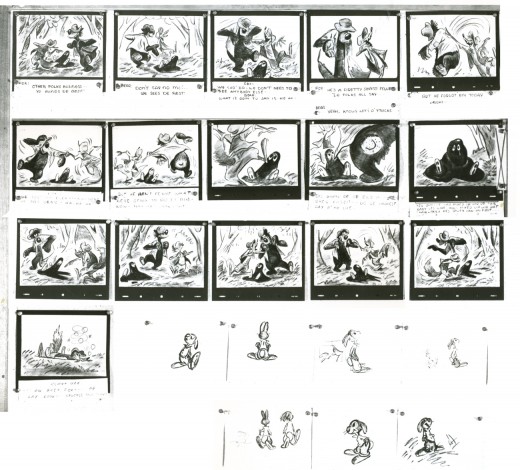 5
5(Click images to enlarge.)
And here are the same two boards broken down by rows:
 51
51
Bill Peckmann &Books &Comic Art &Disney &Illustration &Peet 20 Nov 2012 07:07 am
Moores’ “Jim Hardy” & “Lambert”
- Recently, on this Splog, we saw Dick Moores, who would eventually replace Frank King as the artist behind Gasoline Alley, as the artist behind the beautiful comic books featuring Mickey Mouse. Bill Peckmann continues with the Disney artist, Moores, as he gives us Lambert the Sheepish Lion, Bill Peet’s tale.
But first we saw an early strip drawn by Moores, “Jim Hardy”. Bill Peckmann is here to present some of the Moores history:
- When Dick Moores was assisting Chester Gould on his ‘Dick Tracy’ strip in the 1930′s, his big dream was to eventually have a daily strip of his own. In 1936, he was finally able to fulfill that wish with the comic strip ‘Jim Hardy’. It lasted from 1936 to 1942. He left ‘Jim’ to join the ranks of the Disney comic strip dept. in ’42.
- In this 1977 Hyperion Press’ book of reprints we get to read Dick’s version of how the strip came about (and what a sweet read it is) and also included are the first 21 dailies of the strip.
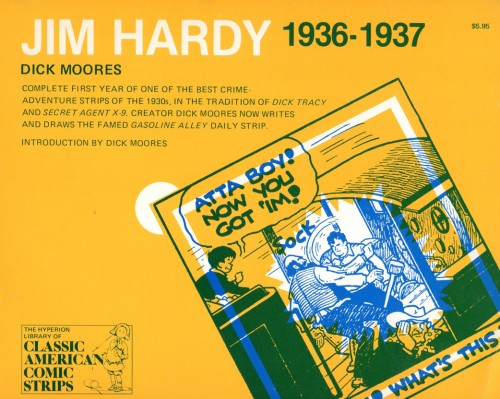
The cover page of this Hyperion Press collection of strips.
 15
15
Thanks to Germund Von Wowern we have an original ‘Jim Hardy’ strip from the early 1940′s. Beautiful ink work! (Sorry about the rubber cement stains in the word balloons, those are left over from re lettered foreign language versions of the strip.)
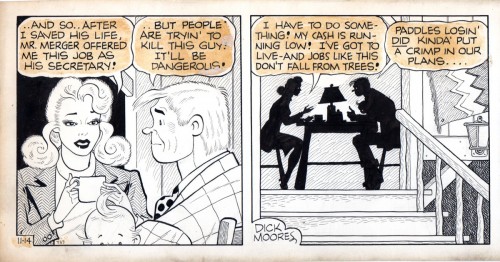 16A
16A
Here, I’ve broken the original strip into two parts
so that we can see it fully enlarged.
In this 1953 story Dick Moores had a great time adapting the Disney short ‘Lambert, the Sheepish Lion’ to the pages of a comic book. The more I look at the art, the more I start to get the feeling, that in Dick, the cartoonist, there was always an illustrator trying to get out. Some of these panels would have made pretty good page illustrations. (Which makes one wonder and dream of what a comic book page would have looked like if it had been done by the one and only Bill Peet!?!)
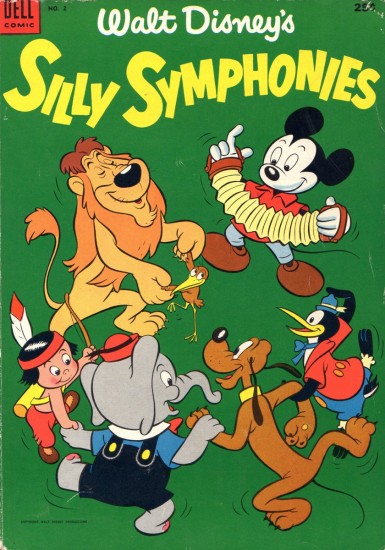
The comic book cover which contained Lambert.
In Part 2 we’ll continue celebrating the art of Dick Moores and the release of Library of American Comics’ “Dick Moores’ Gasoline Alley”!
Animation &Disney &Peet &Tytla 10 Sep 2012 05:10 am
Dumbo Takes a Bath
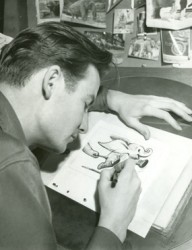 - Bill Peet was a masterful and brilliant storyboard artist. Every panel he drew gave so much inspiration and information to the animators, directors and artists who’ll follow up on his work.
- Bill Peet was a masterful and brilliant storyboard artist. Every panel he drew gave so much inspiration and information to the animators, directors and artists who’ll follow up on his work.
This is the sequence from Dumbo wherein baby Dumbo plays around the feet of his mother. Brilliantly animated by Bill Tytla, this sequence is one of the greatest ever animated. No rotoscoping, no MoCap. Just brilliant artists collaborating with perfect timing, perfect structure, perfect everything.
Tytla said he watched his young son at home to learn how to animate Dumbo. Bill Peet told Mike Barrier that he was a big fan of circuses, so he was delighted to be working on this piece. Both used their excitement and enthusiasm to bring something brilliant to the screen, and it stands as a masterpiece of the medium.
Of this sequence and Tytla’s animation, Mike Barrier says in Hollywood Cartoons: What might otherwise be mere cuteness acquires poignance because it is always shaded by a parent’s knowledge of pain and risk. If Dumbo “acted” more, he would almost certainly be a less successful character—”cuter,” probably, in the cookie-cutter manner of so many other animated characters, but far more superficial.
I had to take the one very long photstat, on loan from John Canemaker, and reconfigure it in photoshop so that you could enlarge these frames to see them well. I tried to keep the feel of these drawings pinned to that board in tact.
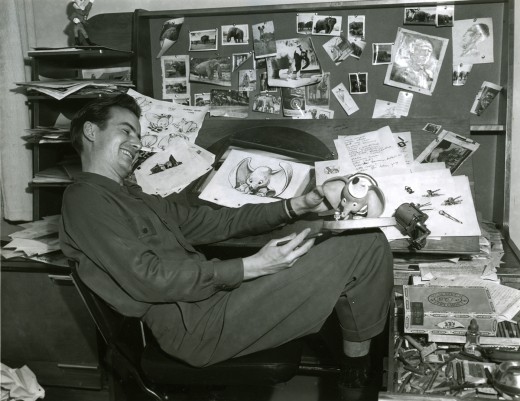
Bill Peet at his desk on Dumbo.
_______________________________________________
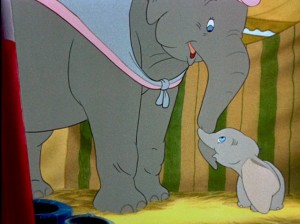 I think this sequence where Dumbo gets washed by his mother and plays around her legs is one of the greatest ever animated. There’s a sweet tenderness and an obviously close relationship between baby Dumbo and his mother which is built on the back of this sequence. It not only establishes both characters solidly, without words, but it sets up the mood of everything that will soon happen to the pair during the remaining 45 minutes of the film. Without that established bond, the audience wouldn’t feel so deeply for the pair during the “Baby Mine” song or care so much about Dumbo’s predicament.
I think this sequence where Dumbo gets washed by his mother and plays around her legs is one of the greatest ever animated. There’s a sweet tenderness and an obviously close relationship between baby Dumbo and his mother which is built on the back of this sequence. It not only establishes both characters solidly, without words, but it sets up the mood of everything that will soon happen to the pair during the remaining 45 minutes of the film. Without that established bond, the audience wouldn’t feel so deeply for the pair during the “Baby Mine” song or care so much about Dumbo’s predicament.
Tytla has said that he based the animation of the baby elephant on his young son who he could study at home. Peet has said that Tytla had difficulty drawing the elephants and asked for some help via his assistant. There’s no doubt that both were proud of the sequence and tried to take full credit for it. No doubt both deserve enormous credit for a wonderful sequence. Regardless of how it got to the screen, everyone involved deserves kudos.
Here are a lot of frame grabs of the sequence. I put them up just so that they can be compared to the extraordinary board posted yesterday. Both match each other closely. Whereas the board has all the meat, the timing of the animation gives it the delicacy that would have been lost in a lesser animator’s hands, or, for that matter, in a less-caring animator’s hands. The scene is an emotional one.

(Click any image to enlarge.)

Animation Artifacts &Disney &John Canemaker &Peet &repeated posts &Story & Storyboards 28 Nov 2011 07:45 am
Ben and Me Board – repost
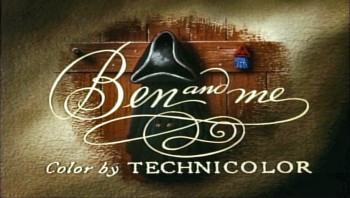 - Bill Peet was one of the prime artists who shaped many of the Disney features. He has been an enormous influence on me and thanks to John Canemaker, who has loaned me the following storyboard, I’m pleased to post some of Mr. Peet’s excellent artwork.
- Bill Peet was one of the prime artists who shaped many of the Disney features. He has been an enormous influence on me and thanks to John Canemaker, who has loaned me the following storyboard, I’m pleased to post some of Mr. Peet’s excellent artwork.
Ben and Me was a 20 min short produced in 1953. It’s an oddity in the Disney canon. The story of a mouse who influences Benjamin Franklin through many of his most famous moments was originally a book by Robert Lawson and was adapted by Bill Peet for the studio.
The photostats of the storyboard, like others I’ve posted, is extremely long. Hence, I’m posting them as large as I possibly can so that you’ll be able to read them once you’ve enlarged the images.
These three panels are followed by a couple more revisions. The revisions I only have as xeroxes – lesser quality.

This image is a recreation of the extraordinary pan as seen in the first row of the storyboard posted above. It’ll enlarge to a size where you can properly see it. A couple of the objects were on secondary overlays creating a minimal multiplane effect.
Bill Peet offered great drawings in his storyboards, and I’m sure he brought a lot of inspiration to the animators.

This is an excedingly long pan (30 inches), and is almost invisible in this minimal thumbnail. Rather than break it up into shorter bits, I’m posting it as is and hope it won’t be too much of a problem for you to follow in its enlarged state. You have to click on it to see it.
The image below is a recreation of this pan from the final film done using multiple frame grabs.
There’s an excellent article about the making of Ben and Me by Wade Sampson at Jim Hill Media. It gives quite a bit of information about this odd short and is well worth reading as a companion to these boards.
Bill Peckmann &Books &Peet 05 Apr 2011 07:06 am
Peet’s Capyboppy – Part 4
- Bill Peet‘s Capyboppy was published in 1962. It’s one of the best examples of his book illustrations. The images are all B&W and are strong drawings, all.
The book feels like a close relative to Bill Peet: An Autobiography. (For those of you in animation, you ought to have a copy of this book on your bookshelf. It’s one of the finest biographical books by an animation veteran, and it’s completely illustrated by him. It’s an original.)
Once again, I don’t post Peet’s writing; you’ll have to get the book for that (and it’s worth it.) I do, however, summarize the story under each illustration so that they make sense.
To view the other parts of this post: Part 1, Part 2, Part 3
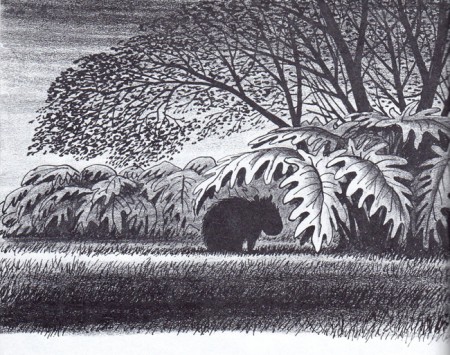 1
1We worried about Capy’s depression. He just sat there
doing nothing and couldn’t be pulled out of it.
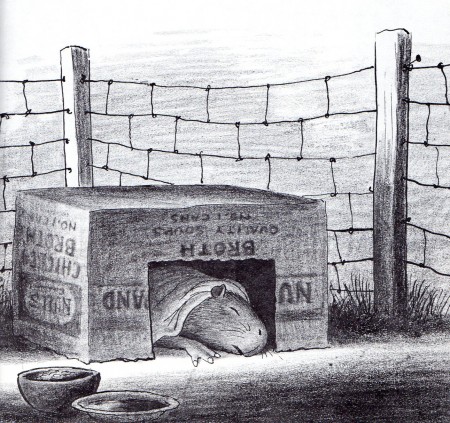 2
2
The same continued the next day. Steve was already there feeding him and
giving him water, but Capy didn’t move. We only knew he was alive by the breathing.
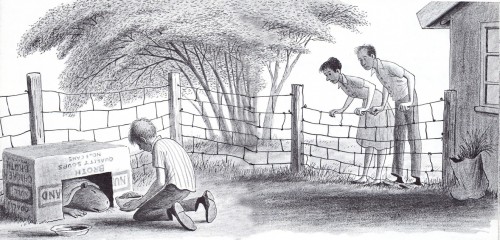 3
3
On the second morning, things remained the same. we heard from Tommy.
His head was better and he wasn’t mad at Capy for hurting him.
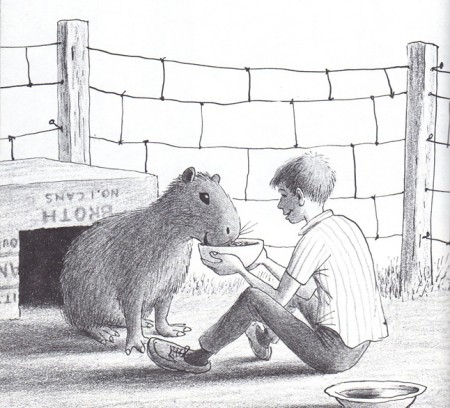 4
4
By the third day, Capy had gotten better. He sat up and was
drinking water and eating a little food. He seemed to be happy.
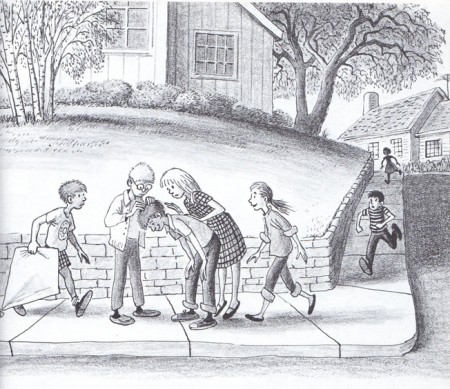 5
5
Meanwhile Tommy had become a local celebrity. His scar from Capy’s scratch
was a hit and every kid wanted to see. We were afraid other children would
want to be scratched by Capy and we began to think how we could avoid this.
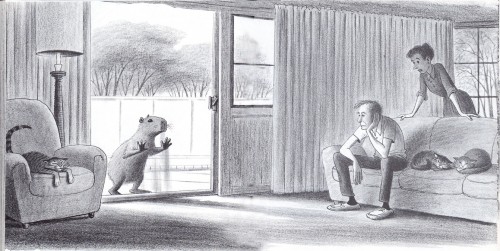 6
6
I suggested donating Capy to the Los Angeles Zoo.
Margaret said that’d be like sending him to prison. Why not send him
back to South America with a note that he should be released into the jungle?
Then she suggested we bring him there, ourselves.
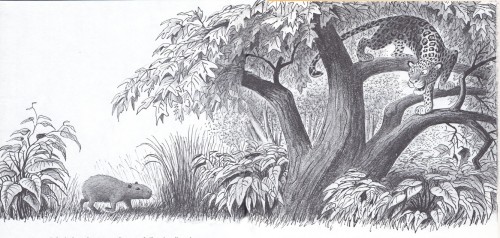 7
7
We agreed. But we worried that Capy wouldn’t survive in the jungle.
He’d want to play with the other animals, and they’d want to eat him.
At this point, Bill, our son, returned from Mexico.
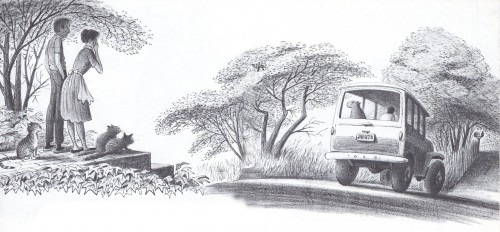 8
8
We discussed the problem with Bill and we tossed and turned
over the decision for many days. Finally, one day Bill picked up
Capy and put him into his jeep. He drove him to the Zoo.
Margaret cried, but aI reminded her that the Zoo was only a half-hour’s
drive away and we could visit him any time we wanted.
On the third visit, Capy shared his pen with a pair of huge hippos.
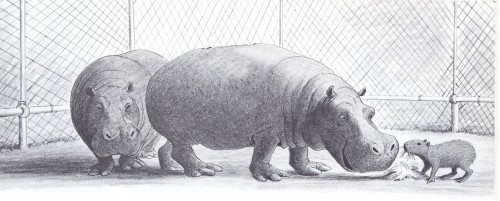 9
9
The zookeeper told us it wasn’t a mistake, and
Capy even rode around on their backs.
We watched as Capy and a hippo fought over some grass to eat.
The hippo won and we worried that Capy would go hungry in this pen.
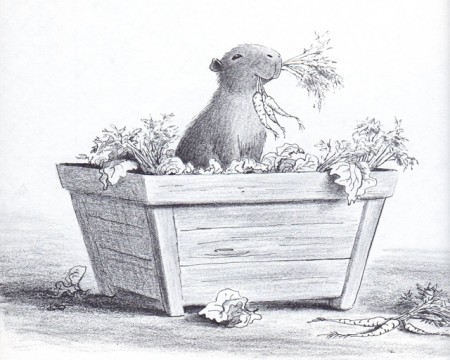 10
10
So we sat across the way on a park bench until feeding time.
The hippos were playing in the pool and Capy was having a feast.
We should have known the ultimately Capy would have his way.
If anyone was to have his way in the pen it’d be our Capyboppy.
This posting concludes Capyboppy. Many thanks to Bill Peckmann for introducing the book to me and sharing it with all of us.
Bill Peckmann &Books &Daily post &Peet 01 Apr 2011 07:32 am
Peet Sampler – 2
- Last week I posted samples from half of the Bill Peet books in Bill Peckmann‘s collection. Here, I give you a sampler of the other half. They add up to 26 books. Not bad considering 34 of them were published by Peet. This puts him just behind Maurice Sendak and Dr. Seuss as the third most prolific American children’s book author/illustrator.
As with the other Peet postings, I’ve eliminated the text from the illustrations. I hope this will encourage many of you to buy some of these books. Personally, I’d start with Bill Peet: An Autobiography.
Many thanks to Bill Peckmann, of course, for sharing.
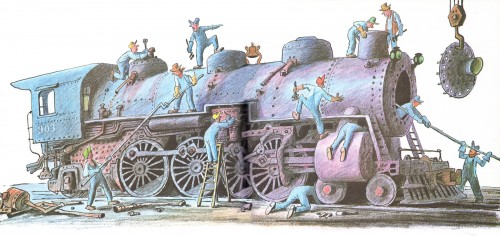 14
14The Caboose Who Got Loose – 1971
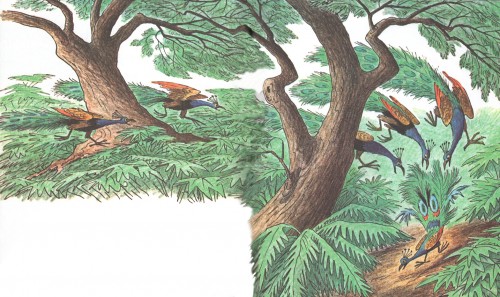 15
15
The Spooky Tail of Prewitt Peacock – 1973
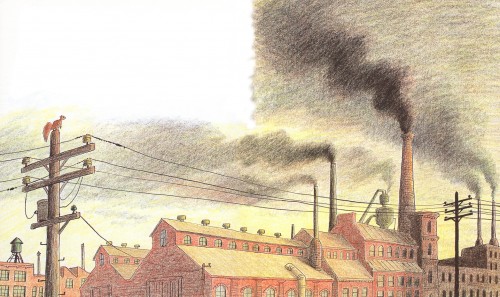 16
16
Merle the High Flying Squirrel – 1974
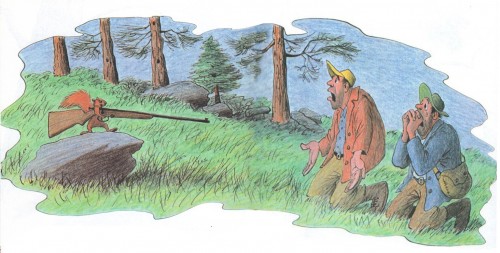 17
17
The Gnats of Knotty Pine” – 1975
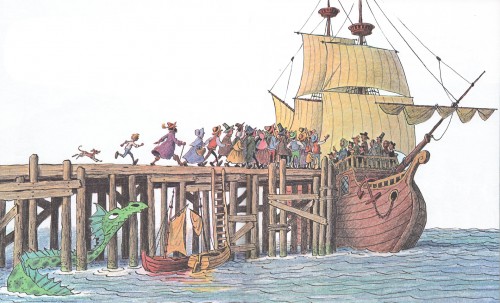 18
18
Cyrus the Unsinkable Sea Serpent – 1975
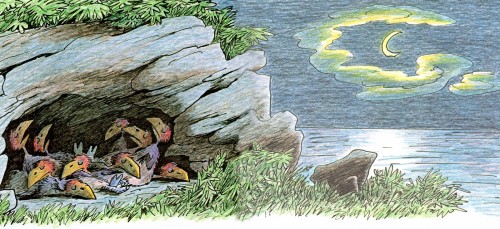 24
24
The Kweeks of Kookatumdee – 1985
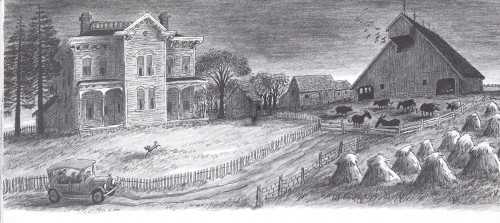 25
25
Bill Peet – An Autobiography – 1989 #1
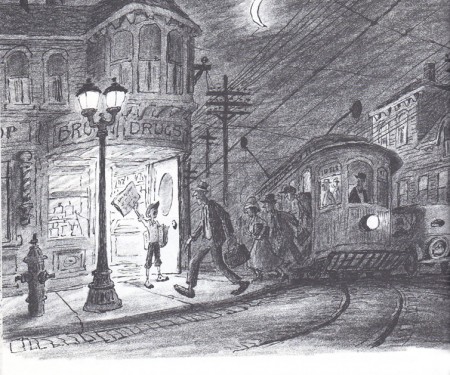
Bill Peet – An Autobiography – 1989 #2
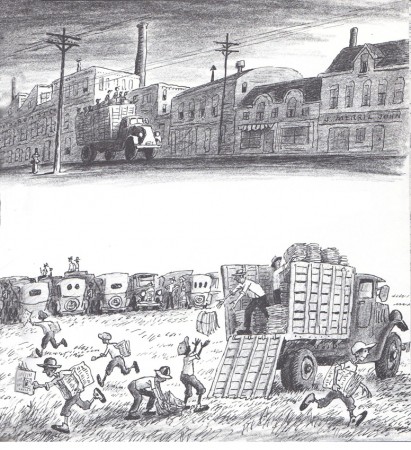
Bill Peet – An Autobiography – 1989 #3
Bill Peckmann &Books &Illustration &Peet 25 Mar 2011 07:41 am
Peet Sampler – 1
- Bill Peckmann owns 26 of the children’s books by Bill Peet. We’re coming to the finish of posting his beautiful book, Capyboppy, and we thought as a follow-up it’d be best to post a sampler from each of these 26 books. We’ve taken a double page spread from each that Bill has scanned and forwarded to me. I’ve done my best in photoshop to link the two together.
Here, in chronological order, are the first 13 of the books in Bill’s collection. By putting them in order, we can see the development and growth of his illustration style.
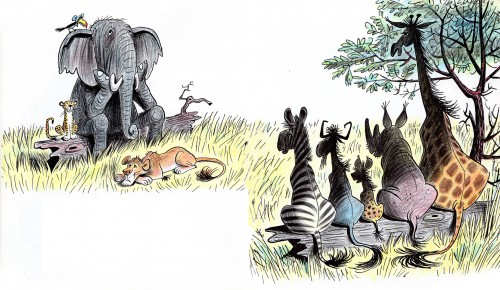
“Hubert’s Hair-Raising Adventure” – 1959
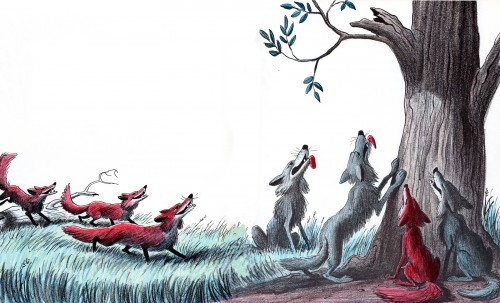
“The Pinkish, Purplish, Bluish Egg” – 1963
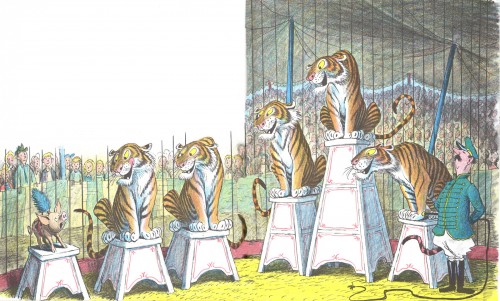
“Chester, the Worldly Pig” – 1965
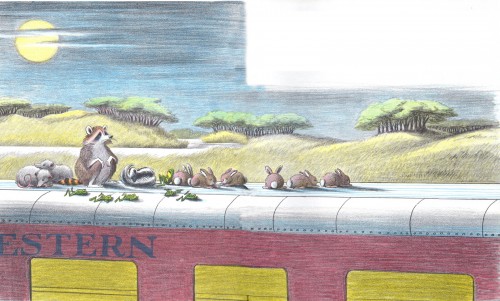
“Farewell to Shady Glade” – 1966
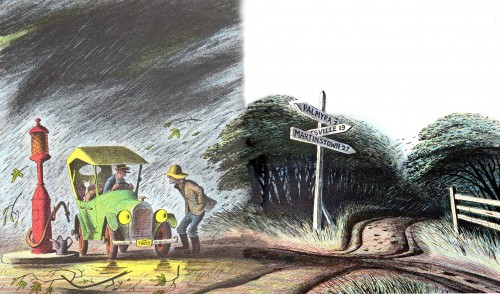
“Jennifer and Josephine” – 1967
Bill Peckmann &Books &Peet 22 Mar 2011 07:48 am
Peet’s Capyboppy – Part 3
- Continuing my posting the fine illustrations by Bill Peet for his book, Capyboppy we go to the third part. As I’ve written with the first two parts, I’m not including Bill Peet’s text; I prefer just to focus on his illustrations. However, I do synthesize the story so that the illustrations make sense.
So, here are those illustrations which Bill Peckmann scanned from his copy of the book:
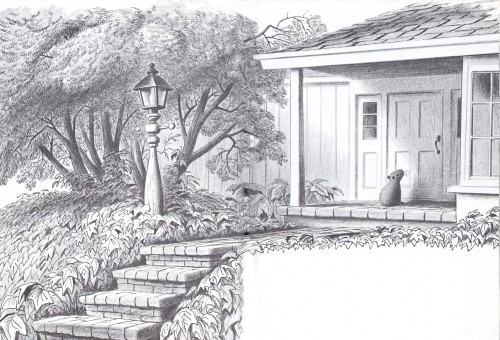 1
1Capy sat on the front porch waiting for us to let him in.
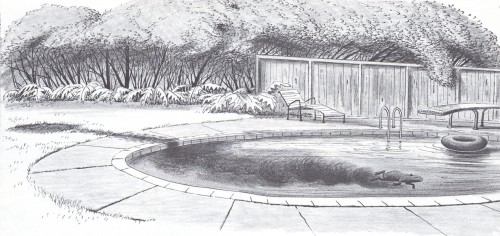 2
2
He got into the habit of rolling in the mud and
getting into the pool to clean off. This made
the pool a dirty brown color. We solved this
problem by putting an old inner tube onto the
mudwallow, which Capy grew interested in.
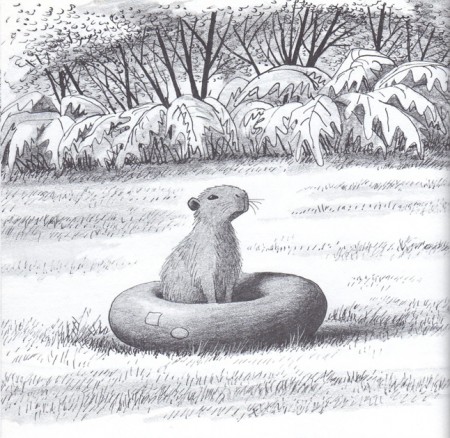 3
3
Capy settled into the inner tube and was irritated
that he couldn’t get to his mudwallow.
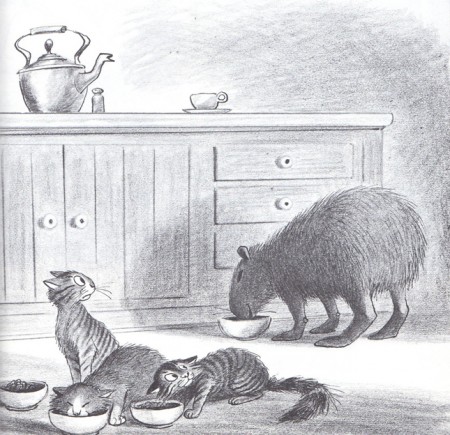 4
4
He was getting to be headstrong.
He ate more and grew bigger.
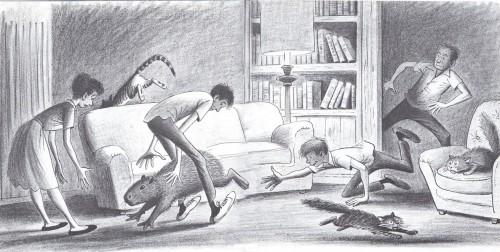 5
5
Capy still rested on the sofa in evenings, however he started to get smart.
When he knew it was bedtime, he’d jump onto the ground and raced down
the hall. Just when we’d cornered him and were about to catch him,
he’d slip our grasp.
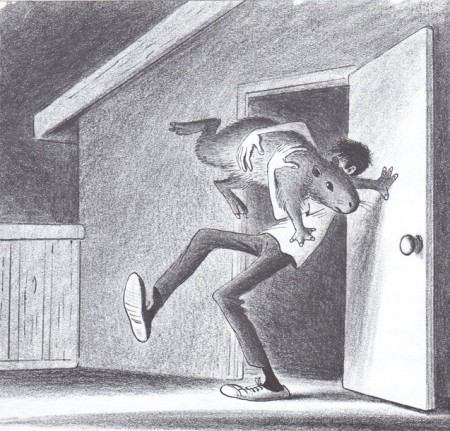 6
6
Even when we caught him, he was a handful
kicking, scratching and tossing about.
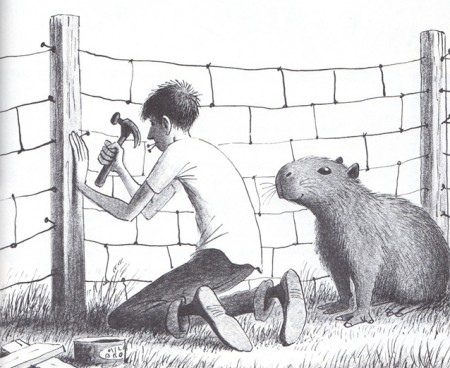 7
7
Bill helped build a pen to safely lace him in, and then
our son left to go on a month-long trip to Mexico.
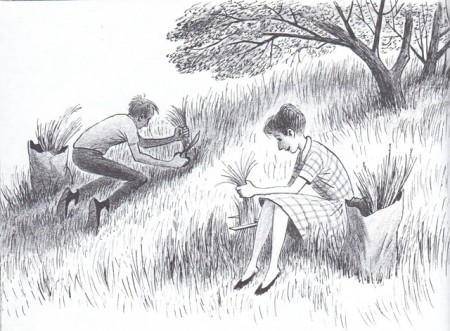 8
8
We used fresh grass that was gathered on the hill
to lure Cappy back into his pen.
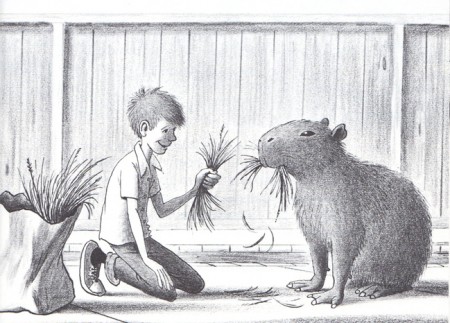 9
9
One day we allowed him to eat more than a handful.
A young friend, Tommy, kept feeding Cappy who finally
jumped at Tommy and scratched him on the head.
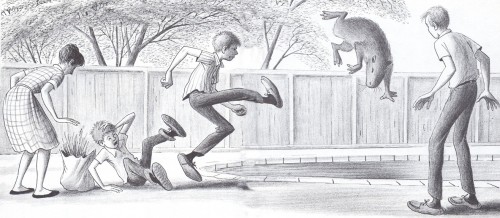 10
10
Tommy screamed and shouted and Capy lept into the pool and
settled on the bottom. Tommy was taken to the hospital and
I went to keep an eye on Cappy.
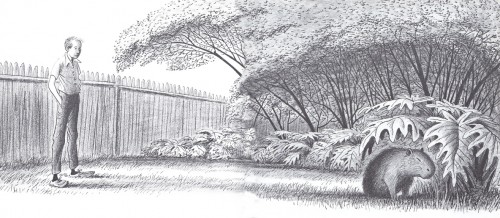 11
11
Cappy had settled in the bushes not moving. I wondered what
had caused his sudden anger, but wondered if it weren’t sudden.
Maybe he’d been building up his resentment of humans. He was a
sensitive animal. Perhaps, in some way he thought he was being
punished. Tommy returned from the hospital and
I turned to find out what news they had.
Again, many thanks to Bill Peckmann for scanning the book.






















